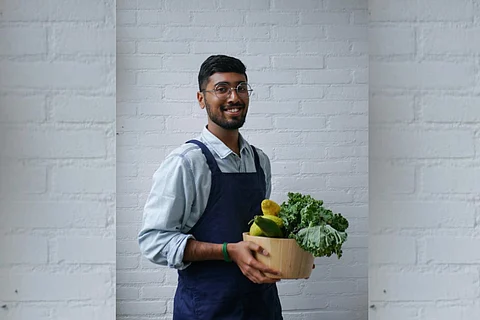

For Akash Muralidharan, food and the joy that comes with cooking, has always been a part of his life. “I think I’ve enjoyed cooking and food from the time I’ve been conscious,” he chuckles. Perhaps this was also a reason why he chose to embark on a quest to find out about the forgotten vegetables from our meals today. Akash’s ‘100 days of Cooking’ project on Instagram just ended and has definitely caught the fancy of food enthusiasts.
Having grown up in a joint family, he attributes most of his inspiration to his grandmother. “My grandmother was a prominent figure in the household and the kitchen was my favourite space in the whole house. I’d spend a lot of time around the kitchen, chatting and just being curious about what she does. I think my interest in food might have stemmed from my relationship with my grandmother and the kitchen,” he adds.
The 25-year-old from Chennai studied architecture before swinging around and doing his Masters in Food Design and Innovation from Scuola Politecnica di Design (SPD) in Milan, Italy. But this decision was not entirely a surprise to him. “I wanted to pursue something I could specialise in and I found architecture to be too mainstream at that point. It was a very last minute decision but my portfolio interested them at the Institute. The course helped me expand my interests and I realised I enjoyed working with food everyday. My background helped me get creative with food,” he explains.
After an internship with a food designer in Amsterdam, he was back home in Chennai. Now, a part of The Centre for Genomic Gastronomy, a group of artists, who work together virtually from around the world, Akash has been spending his time studying about food and human behaviour, designing food, and presenting his thoughts through exhibits and workshops.
‘Have you seen them?’
According to Akash, food has a lot of untapped potential. And it is in this strain of thought that he began studying the South Indian vegetarian platter. “I found cookbooks that belonged to my grandmother, notes that my mother had written down in her diary, letter exchanges with recipes in them, a whole bunch of interesting things while cleaning out our attic,” he says.
While Akash derives pride from his knowledge about cooking, names like ‘Thummatikai’ (country cucumber), ‘Rasavalli Kizhangu’ (purple yams) and ‘Vetrilai valli kizhang’ (air potato) from the cookbooks, baffled him.
With his curiosity piqued, Akash plunged himself into research, “I spoke to my neighbours, noted their responses on whether they’ve tasted or even heard about these vegetables,” he says. And this is how he started what would go on to become a 100-day project, equipped with a battered copy of S Meenakshi Ammal’s Samaithu Paar and his passion for cooking. He picks one vegetable a day and uses Meenakshi Ammal’s austere notes to do the rest. “My mother Sundari Muralidharan has been a great support. We work on these recipes together,” he adds.
“Thummatikai is the country cucumber and is mentioned a number of times in Samaithu Paar. Unfortunately, I could not find it anywhere in the city. I scoured markets, called friends… no one had heard of it,” Akash explains. “Although, I did find the sun-dried thummatikai in Pazhamudhir Nilayam,” he adds.
This vegetable with its white and green stripes, from pictures, looks like a watermelon on the outside, but only grows up to a size of a big marble. The air potatoes too, Akash tells us, are unusual. “These are tubers that don’t grow under the soil. Instead they are creepers,” he says. Akash puts out simple illustrations of how these vegetables look like on Instagram, done by his friends Priyadarshini Narayanan and Srishti Prabakar, along with short notes on the variety itself based on internet searches.
For instance about the purple yam, he writes that they can be boiled, roasted, cut into discs and baked or fried into chips. While in India they are used to make savory vegetable and curry dishes, like we do with potatoes, in the Philippines, they are even made into jams.
What would be on your plate in 10 years?
Akash was in Dubai this January presenting their team’s explorative study on what the United Arab Emirates would be eating in 10 years from now. “We studied how their food has changed over the past two decades and we presented four alternative futures with different stories that they could choose from. It was to show how their decisions right now could be influencing what they ate 10 years from now,” he shares.
This project, he is now extending to the south Indian vegetarian platter. “For us to be able to visualise what we’d be eating 10 years, we’ll have to go back 20 years in time. If we study what has happened in our past, we can answer the questions about our future,” he says.
According to him, over the last 20 years, our eating patterns too have changed drastically. “It has made me realise that there is a vast difference between what we ate in 2000 and what we eat today in 2020. The culinary landscape has changed. I wanted to know why these vegetables have fallen off our plates,” he explains and adds, “I can tell you now that if we don't make some changes, many more vegetables could follow the same route.”
Akash talks about how markets influence what we buy and how they dictate our diets. “I’ve been doing a survey with about 25 to 30 home cooks in Chennai, asking them about their shopping lists and how they plan their meals. It was a revelation to me that people don’t give this much of a thought. They are happy with the 15-20 vegetables that are available in the market. But if this were to continue, we would risk losing more variety,” he points out.
With his 100-day project, that’s part of this bigger idea, Akash plans on writing a book.